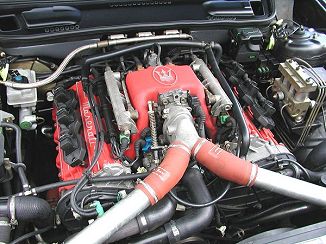My brief to the engine tuning company, giving a set of anticipated minimum results from the Motec M600 installation, was along the following lines:
Make full possible use of the performance exhaust system.
Get turbos spooling up sooner and harder, providing better low-rev accelerator response and more torque.
Maximum torque to be still achieved by 4,000 rpm (or lower) and to at least match the 315 lb ft of the FQ330, but ideally reaching up to 330 lb ft at 4,000rpm. (Remember that the FQ330's 315 lb ft torque is only achieved at 5,000 rpm).
Bring the power curve down, achieving maximum power closer to 6,000 rpm (down from 6,750 rpm) and exceeding 310 rwph (over 350 flywheel horsepower, based on my 12.5% calculation). Although this might appear to be requesting a 29% power increase (240 rwhp up to 310 rwhp), consider that the 240 rwhp was being achieved by 5,500 rpm. If the boost issue were resolved, as necessity dictates, then the actual requested power gain would be under 25%.
0-100kph to below 5.0 seconds (down from the 5.6 seconds believed to be actual time for a standard Ghibli Cup).
Quarter mile to be achievable in less than 13 seconds.
Engine and turbos to operate at safe temperatures, giving consideration to intercooler capacity and engine/turbo longevity. Also, ensure that stress on rods and pistons is not excessive.
Fuel mapping optimised to help with fuel economy.
Extend fuel cut-off to 7,000 rpm.
If the above goals were all achieved, then I would expect the car's top speed to increase from 167 mph to something in the region of 175 mph. |
Firstly let me point out that the car has, after all, been left totally standard other than the new ECU. The turbo boost has not been increased, the standard injectors and intercoolers are being used and no performance enhancements have been made. All engine components (other than dump valves) are still those of a standard Ghibli Cup.
It became clear that leaving the car running standard boost would prevent it from making proper use of the performance exhaust, which was a shame due to the potential offered by the exhaust system. The Motec was able to get the standard car achieving 343bhp (same as a new M3) but at an amazingly low 6,017rpm. However, at this point the injectors were at their limit so the power curve then began to trail off, dropping back to just below 300bhp by 7,000rpm. From 5,000rpm through to 7,000rpm the car is now producing over 280bhp, which is an amazing achievement from a 2-litre engine and gives the car quite unbelievable acceleration. With that much power available the car is now clearly capable of 0-100kph in under 5 seconds.
It is also apparent that with larger injectors and running more boost-pressure the car would be achieving over 380bhp at 7,000rpm. A low-cost option to upgrade further is now available to me should I ever wish to take it.
Rear wheel horse power is about 309 (same as peak torque). If I now apply the 12.5% calculation for flywheel horsepower, then the car would actually be achieving around 348bhp (or 355bhp if calculated as 15%).
The turbos seem to spool-up faster now, and the turbo dial on the dashboard seems to move to the 3PM position faster that it previously did. With 300bhp arriving by 5,200rpm the car feels very powerful at high revs. A normal Ghibli Cup, according to Maserati, would not achieve 300bhp until after 5,800rpm and then reach 330bhp by 6,750rpm by which time the rev-cut-off would occur. My car has reached 330bhp by 5,500rpm and maintains over 330bhp until 6,600rpm. My car is now designed to rev up to 7,000rpm, giving a fraction more response time to change gear.
Another massive benefit I seem to have gained is that the car responds well when cold. Previously the car was very sluggish in the mornings when the engine was cold. Now, it drives the same cold as it does warm, which allows the driver to determine how best to protect the cold engine rather than letting the ECU make that decision for him.
The Motec is amazing in what it can diagnose. For example, when it was first fitted to the car it immediately identified two minor faults:
The alternator was spiking every 72 seconds!
One of the blow-off (dump) valves was not performing correctly due to cracked plastic housing, resulting in them both being replaced by more modern aluminium alternatives.
The only fitting problem came when trying to control the timing, since previously each of the two ECUs had monitored three timing teeth to manage its cylinder bank. New teeth had to be made for the Motec to monitor so that it had six teeth for controlling both cylinder banks together. It had been noted prior to Motec fitting that the two ECUs had not been managing the timing correctly, despite me recently paying £5,000 for a full service. Part of my power problem may have been due to the timing problems.
From this point onwards, any Motec engineer will be able to diagnose any fault and fix it immediately. Also, the ECU is fully programmable, meaning that the car can be remapped and optimised for any future change (performance enhancement, exhaust change etc).
The blow-off (dump) vales make a gentle howl as the accelerator pedal is released, which works well with the moderate growl of my stainless exhaust system. The car sounds the business!
Now for the bad news…
The car is still down on torque. Although it now makes 309lbs/ft torque (instead of the intended 275lb/ft torque), this is achieved at a disappointingly high 5,500rpm. At 4,000rpm the car is only achieving 210lbs/ft torque. Although this sounds pathetic, in reality the speed of the turbo spool-up makes the car feel like it has much more torque, so this low mid-range torque figure is actually quite misleading. I would expect the actual mid-range accelerator response would amaze anyone – despite the low torque figure the car does pick up very quickly from around 3,000rpm because turbo boost is now delivered very quickly. And, why would anyone be trying to accelerate hard from below 3,000rpm?
This is exactly the same 4,000rpm torque figure that my car was making previously, with the two Maserati ECUs. The Motec has confirmed that everything under the bonnet is performing perfectly, so this torque limitation must be caused by the free-flowing exhaust system that provides less back-pressure than the standard exhaust system. Although the dyno-chart indicates that the exhaust can help the car achieve over 380hp, it would need enhanced injectors and above-standard boost to do so. If I choose not to enhance performance further then I may consider restricting the exhaust system somewhat, so that the 343bhp is still achieved, but also so that more low-rev torque is also possible.
Currently I do not have a working rev-counter, making exact comparisons tricky, since the Motec engineer could not determine how to connect it. He has ordered a Ghibli manual to get the necessary information, since not a single UK Maserati specialist could tell him how to connect it! – Scary that Maserati specialists seem to have so little knowledge about Ghibli Cups. I've found myself speaking directly to Ferrari UK in the past when no Maserati specialists could answer questions on the car.
I have been told to drive the car for two weeks to determine if everything is working correctly. So far there has been one minor problem where the car can slightly misfire when I fully depress the accelerator pedal when driving at speed in the higher gears. It is only a brief dip in power before the car eagerly grips the road and throws me back in my seat. The car has iridium spark plugs fitted, so misfires should not be possible.
Overall
I am pleased by the impressive acceleration across the gears, but the engineers managed to crack one of my headlights and failed to improve the low-rev torque, so I'm not as happy as I might have been.
I realise that the performance exhaust changes the torque curve, making it flatter at low revs, but I had thought the Motec ECU would be able to compensate. It is now clear that, unless I plan to enhance performance further, the exhaust is more free-flowing than it needs to be. A restrictive exhaust can hinder performance, but it can also help to regulate back-pressure. Getting the perfect balance between performance and torque is not easy.
I will probably go for a compromise, adding some restriction back into my new exhaust system, whilst retaining the performance cats, and see if it helps. Any additional restriction should increase the low-rev torque, although anything short of a standard system may fail to achieve 275lbs/ft by 4,000rpm. The free-flowing nature of my new exhaust does have benefits over the standard system, which I have no desire to lose.
Despite my desire to have a higher 4,000rpm torque figure, I should once again point out that mid-range accelerator response is very impressive due to the speed at which the turbos now respond. I have no doubts that may car would cover a standing quarter-mile much quicker than any standard Ghibli Cup.
Comparison with FQ330
Of course, the FQ330 is now a bit dated. The new models being MR FQ 320, MR FQ340 and MR FQ400.
The company I chose to fit the Motec happens to be the company that makes the FQ upgrades for Mitsubishi. They fit a Motec M800 (the most powerful Motec ECU) to the FQ400, along with a new Garrett turbo, replacement rods/pistons etc.
After they did my car, I was told its acceleration pulling away from roundabouts did not feel dissimilar to that of a FQ 400, although my car would obviously not match the 0-60 time and is nowhere near 400hp. The turbo on an FQ 400 does not provide much boost before 3,500rpm, whereas my turbos spool up much sooner and my maximum power is delivered sooner than an FQ400's.
Anyway, sticking to the fairer FQ 330 comparison, I think it is now reasonable to claim that my car is capable of surpassing its mid-range power, even though I might struggle to match it at 0-100kph. The Ghibli Cup was already a finer car than the Evo, but now it has performance to match all but the very quickest model.
Motec Summary
Maximum flywheel horsepower (calculated) 343bhp @ 6,017rpm (348hp 12.5% flywheel, 355hp 15% flywheel)
Maximum torque 309lbs/ft @ 5,510rpm
Maximum rear wheel horsepower 309rwhp @ 6,017rpm
0-100kph acceleration under 5 seconds (4.8 second estimate)
Top speed Unknown (due to change in top-end power delivery)
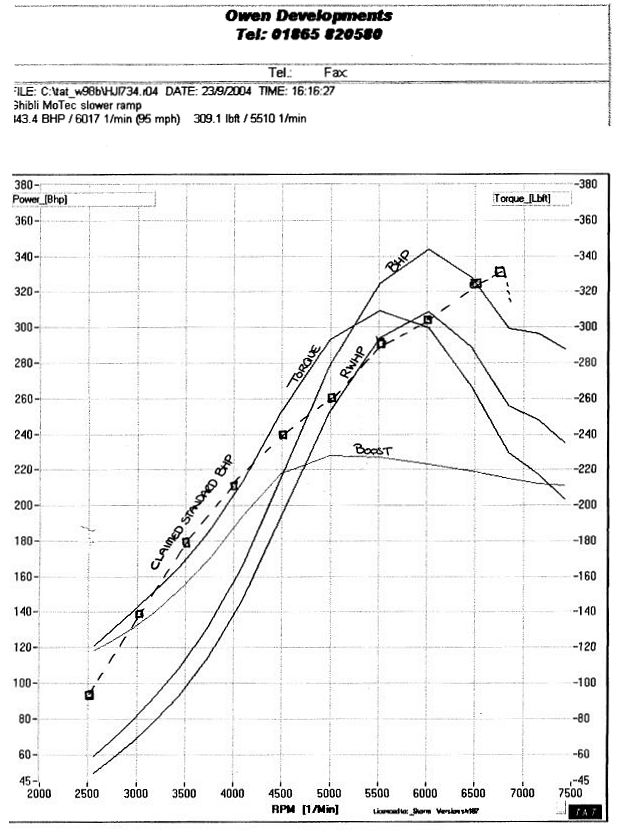
PLEASE NOTE that a conservative 11% flywheel figure is used. Maserati's claimed power is directly taken from the engine. If the flywheel figure was as high as 25%, as some claim, then the car would be actually making 386bhp and the power improvements shown above would be vastly increased, beating standard from 4,500rpm onwards.
Based on the 11% flywheel calculation and Maserati's power claims, which I've never seen verified by actual owner's dyno print-outs, my car begins to surpass the standard power delivery at 4,700rpm and drops back below standard power delivery after 6,600rpm, peaking at around 35hp more at 6,000rpm. Considering that most acceleration is performed between 5,000rpm and 6,750rpm, the performance increase over standard is not insignificant. Also, the figures do not reflect the amazingly fast spool-up of the turbos on my car.
Driving around town the drop in low-rev torque is pretty much compensated for by the speed of turbo spool-up, although maybe an owner of a standard Ghibli Cup would notice a slight difference?
If any owner of a standard Ghibli Cup has ever had it put on a rolling road, then I'd love to hear how much rear-wheel horsepower your car is actually making. |
Four weeks have passed since the Motec was fitted, and during that period I was busy preparing for the final set-up.
Firstly, I really wanted to believe Maserati's torque claims for the car, despite several experts feeling that a standard Cup exhaust was not likely to provide 275lbs/ft by 4,000rpm.
I went back to Stax Engineering and, for an amazingly low £60 inclusive of parts, they made me exchangeable exhaust sections that slotted in behind the cats. The replacement sections were 2-inch diameter pipes (fractionally smaller than standard Cup piping) and both of the sections ran for 17 inches to provide extra back-pressure in the system. The original sections were carefully cut out of the exhaust and had connectors welded to them so that within 5 minutes any mechanic could replace the 2 inch sections with the 2.5 inch sections.
It rained constantly on the day the exhaust changes were made, and virtually every day after, so exact comparisons when driving were difficult. However, I felt there might be a little more torque at very low revs, but it also seemed that acceleration was weaker with the near-standard diameter exhaust sections fitted. The car did seem to feel more relaxed when pulling off in first gear, not requiring quite so many revs.
The first dry day was when I drove back to Owen Developments in Oxford to have the final adjustments made to my Motec settings (with my big-bore exhaust sections in the boot). From my driving experiences of the previous four weeks my brief to Mark at Owen Developments was this:
1. With the standard-sized exhaust sections fitted, see if the 275lbs/ft torque can be achieved by 4,000rpm without any significant loss of top-end power.
2. If the standard exhaust sections prove to be a disaster then re-attach the previous big-bore exhaust sections.
3. Try to optimise low-rev torque whilst achieving and maintaining high power levels for as long as possible (with 330hp still available at 7,000rpm).
4. Address minor misfire problem where turbos are over-boosting when accelerating hard in high gears.
5. Re-connect odometer and lumber support on driver's seat!!!
6. Fix broken headlight.
On my two-hour journey to Oxford I realised that the car was performing weakly. Now that the roads were dry I could accelerate hard without fears of traction loss and I was not happy with the response. The standard size exhaust sections were clearly preventing the turbos from spooling up as impressively as they had upon the Motec first being fitted.
Traction was now better than previously because, due to a serious puncture a week earlier, my car had two new Bridgestone S03 Pole Position tyres fitted to the rear wheels. The old S02 tyres had been fairly worn, so I could be confident that the car was now gripping the road better.
The first thing Mark did was to put the car on the rolling-road with the newly fitted standard-size exhaust sections, after first lecturing me on the fact that turbo cars generally get more power and torque from big exhaust systems. In fact, some of the most powerful two-litre rally cars he has worked on (around 450hp) had something approaching a 5-inch diameter exhaust system to optimise power delivery.
He was proved correct. The car could only make around 294rwhp (326hp flywheel) with the standard exhaust section, and the low-rev torque was virtually unchanged. It started to seem unlikely that Maserati's claimed 275lbs/ft torque at 4,000rpm was actually achievable with the engine fitted to the car. I think it is also fair to question whether the standard car can really make 330hp at the flywheel, since even with a Motec and performance cats the best we could get was 326hp (based on 11% calculation). However, for all I know the Ghibli Cup might lose as much as 25% at the flywheel, which would mean a standard Ghibli Cup was only ever intended to make 264rwhp (which would only equate to 293hp at the flywheel based on the 11% calculation Owen Development use).
Just to make it clear that there were absolutely no faults on my car I should point out that Owen Developments put my car in their state-of-the-art fault diagnostic centre for two hours and wired up every component of the engine. This included:
1. Checking turbo boost
2. Checking cat efficiency
3. Checking cylinder compression
4. Checking spark plugs
5. Fuel mapping diagnostics
6. Etc. etc.
Despite my car's fairly high mileage everything was working perfectly, so the car should have been capable of easily achieving what Maserati claim it could achieve. The car was not even suffering from any cylinder compression leakage at high boost.
With my findings, I feel I must ask the following: IF ANYONE HAS EVER HAD A GHIBLI CUP (OR OPEN CUP) ROLLING ROAD TESTED THEN PLEASE SEND A COPY OF THE DYNO PRINT-OUT TO ENRICO SO THAT WE CAN ASCERTAIN IF MASERATI'S CLAIMED FIGURES ARE REALLY ACHIEVABLE. ADDITIONALLY, IF ANYONE KNOWS THE INTENDED RWHP OF A GHIBLI CUP THEN LET ENRICO KNOW.
My concern that power was not smoothly dropping off just before 7,000rpm resulted in Mark connecting his laptop to my Motec and coming out in the car with me for a road test. I took the revs to 7,000rpm a number of times and the laptop computer stored readings from all of the numerous sensor devices that feed the Motec.
The laptop showed that power was being maintained perfectly, with smooth readings from the injectors and the turbos. Any drop-off before 7,000rpm was therefore due to inaccuracies from the rolling road read-out (which may have been worsened by my previously worn tyres and low tyre pressure).
Mark had previously done the rolling-road diagnostics in 4th gear, believing my 2-litre car had only a five-speed gearbox since most the cars he works on tend to be 5-speed. From sitting next to me he realised that the car actually had a six-speed gearbox and he felt that a 5th gear rolling road session might provide more accurate results.
Again, he was proved correct. The 5th-gear rolling road test, with the big-bore exhaust sections refitted, showed the car achieving 345hp (over 310rwhp) by just over 6,000rpm and maintaining over 343hp until beyond 7,000rpm. This was with no changes to the Motec configuration, just running with a reduced rate of acceleration to enable more accurate readings to be achieved.
In 5th gear the rolling road read-out is much smoother and Mark believes the 5th gear read-out to be more accurate for my car, so from this point forward I will use the 5th gear rolling road data rather than the 4th gear data used previously.
The misfire problem I'd experienced had been caused by the Motec ECU getting the turbos to full boost in high gears too quickly, and was easily rectified. Strangely, the misfire had never happened with the standard-size exhaust sections, since the turbos need the big-bore system to be able to spool up very fast. You can easily notice the improvement in acceleration when the entire exhaust system is 2.5-inch diameter and has performance cats. The standard turbo spool-up seems rather pathetic after you have experienced just what the IHI turbos are really capable of doing.
The odometer was reconnected, as was the driver's lumber support (which had been accidentally disconnected when one of the original ECUs had been removed).
Finally, Mark revised the power cut-off to provide maximum engine protection. The new cut-off system would work as follows:
At 6,500rpm the “CHECK ENGINE” warning light would come on to advise the driver to change gear. Obviously, there was not really a problem with the engine!
By 6,750rpm the boost would be noticeably reduced.
By 7,000rpm a controlled power cut-off would have occurred.
I'm guessing that the car's top speed will not have increased, since the high-rev power drop-off should prevent speeds in excess of 170mph from being achievable. However, the “CHECK ENGINE” gear-change system is wonderful. If I wish to accelerate hard I just floor the accelerator pedal, knowing that the car will provide maximum boost until I notice the “CHECK ENGINE” light appear. I then change gear and acceleration is optimised without any significant power-loss. The standard Ghibli system of immediately losing power at 6,800rpm was not very good and tended to sometimes restrict rapid acceleration through the gears. Now, if I accidentally allow the car to rev too high then there is a gentle controlled power drop-off, rather than the original “sudden death”.
The final rolling-road tuning resulted in 350.3hp by 6,038rpm (315rwhp) and, as previously stated, measured in 5th gear instead of 4th.
The final Motec printout showed minor power and torque improvements everywhere, apart from after 6,500rpm when the controlled power cut-off system begins to activate. At 4,000 rpm I still only recorded 213lbs/ft torque in 4th gear, but in 5th gear this figure was shown as a more impressive 250lbs/ft. This makes me wonder if it would have been even higher in 6th gear? - Maybe the 275lbs/ft claimed by Maserati?
I also found that I had 300hp being achieved by around 4,850rpm in 5th gear and maintained until about 6,750rpm.
Basically, my car now has the following attributes that have been verified several times to confirm this is accurate:
1. Maximum rear-wheel horsepower of 315 by just after 6,000rpm
2. Maximum flywheel horsepower of 350.3 using the 11% calculation (or 362hp using 15%; 378hp using 20%; or even as high as 394hp using 25% flywheel calculation). Real flywheel horsepower can not be determined without knowing how much power is lost between the flywheel and rear driving wheels. Many tuning centres use figures of around 15% or 20% when calculating horsepower using a rolling road.
3. Maximum torque of 327.7lbs/ft (443nm) @ 5,079rpm, with 275lbs/ft reached by 4,200rpm.
4. Amazing turbo spool-up. Anyone with a standard Ghibli Cup could not imagine just how quickly and eagerly the turbos can provide boost. With good engine management and a sufficiently free-flowing exhaust system the acceleration on a Ghibli Cup can be vastly quicker than the standard car. I have been able to prove this by using both standard sized exhaust sections and big-bore exhaust sections on the car, with no other differences, and note the performance differences.
I would guess the car now has a 0-60 time of between 4.6 and 4.8 seconds. Not too sure what the quarter-mile time would be, but I might one-day take it to a track and have it timed.
The car is fairly unimpressive below 4,000rpm (190hp), although many might consider 190hp by 4,000rpm to be fairly acceptable. Despite my best efforts it has proved impossible to get decent response/performance at low revs. However, after 4,000rpm the car responds like a rocket has been attached to it. The power-curve from 4,000rpm is very steep, reflecting the unrestricted turbo boost, providing amazing acceleration. From its 190hp at 4,000rpm it jumps to almost 310hp by 5,000rpm (120hp increase in 1,000rpm!) and then to around 350hp by 6,000rpm (all conservatively calculated at 11%). The car maintains over 330hp between 5,250rpm and 6,500rpm (down from 6,600rpm previously due to power drop-off being initiated). A fairly responsive 280hp is available by 4,700rpm and maintained through to around 6,850rpm.
THIS CAR HAS NO ENGINE MODIFICATIONS AND RUNS MANUFACTURER RECOMMENDED BOOST LEVELS. The injectors and injector rails are standard; the turbos are standard and not boosted beyond recommended levels; the intercoolers are standard; the cylinder heads are standard; the crankshaft, cams & pulleys are standard. The only modifications are:
Motec ECU for more efficient engine management and improved mapping.
More efficient exhaust system to allow the turbos to operate without restriction.
Replacement stronger blow-off valves since originals tended to crack.
Iridium sparkplugs to ensure good spark under boost.
Unfortunately, at time of writing this article the headlight is still cracked, but hopefully will be replaced soon. This was due to being let down by a well-known Maserati specialist who failed to process the order, rather than a problem caused by Owen Developments. My advice to anyone owning a Ghibli Cup is this: only use a Maserati specialist for servicing, but for maintaining performance and diagnosing faults go to someone with proven specialist knowledge. Since going to Stax Engineering for an exhaust system and Owen Developments for proper engine management my car has become a totally different beast to drive. Maybe nowhere near as rapid as a 500hp Supra, or even an FQ 400, but much more fun than standard.
My final tip: Whenever considering the power of a car only ever look at the rear-wheel horsepower figure (rwhp). Many people make excessive horsepower claims about their cars, but these are often using high (25% or more) calculations when determining flywheel horsepower (which is the figure you are normally offered since it is higher than rwhp). For example, someone claiming 360hp using a 25% calculation would only be making 288rwhp, which equates to only 320hp when using the conservative 11% flywheel calculation. A car's performance is determined by power at the driving wheels, not by power at the flywheel. If anyone claims to have a modified Ghibli providing lots of power, then ask for a dyno print-out and check that it makes over 300rwhp by at least 500rpm before the rev cut-off occurs. If not, then it probably wont noticeably perform any better than a standard Ghibli Cup and it might perform worse!
Here is a table summarising the rolling road data comparisons…
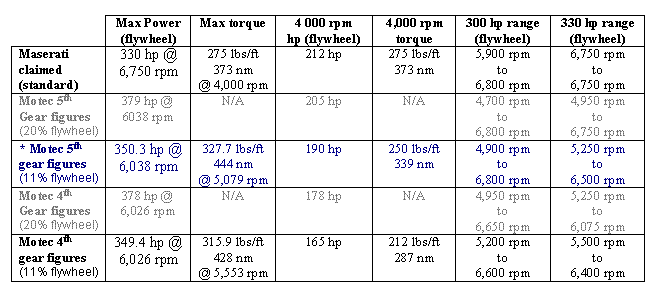
* In the above table the Motec 5th gear figures (11% flywheel) are considered to provide the most accurate power and torque representation for the car and provide the best comparison against Maserati claimed figures. Other figures supplied include the 4th gear statistics and the power figures for a 20% flywheel-to-rear-wheels power loss.
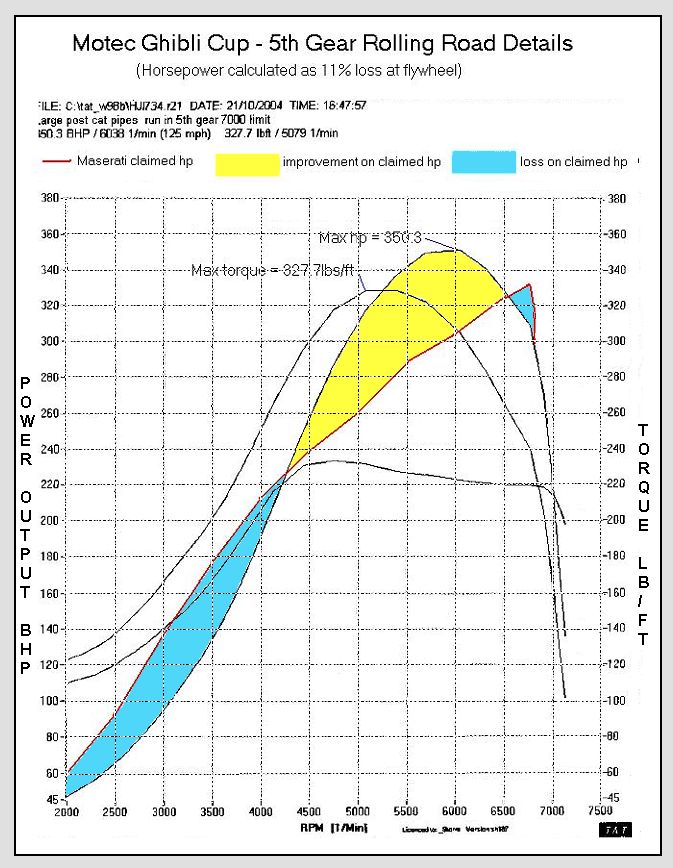 |
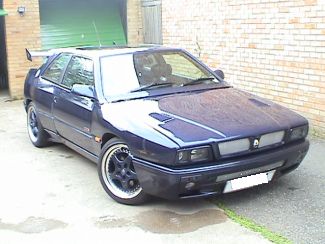
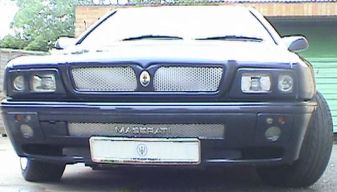
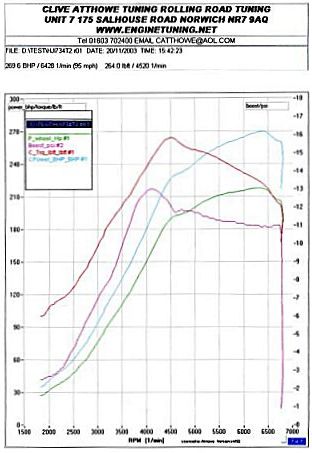
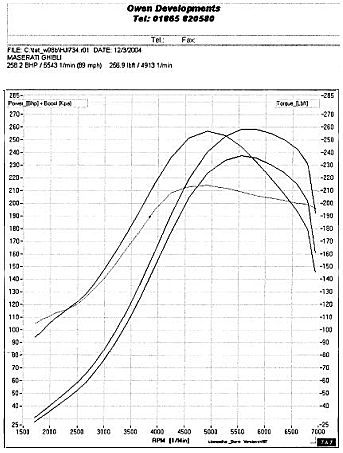

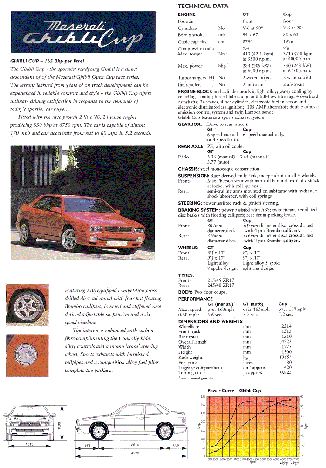

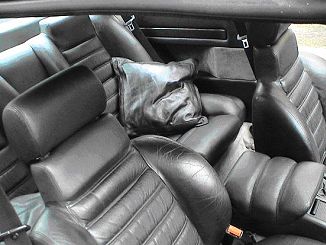 High quality hand-stitched black leather interior with seats that feel like they belong in your living room. Apart from electronic back of seat angle adjustment, the seats are fairly basic (no heating, no memory, no lumber adjustment, pull-bar for moving seats forward and back).
High quality hand-stitched black leather interior with seats that feel like they belong in your living room. Apart from electronic back of seat angle adjustment, the seats are fairly basic (no heating, no memory, no lumber adjustment, pull-bar for moving seats forward and back).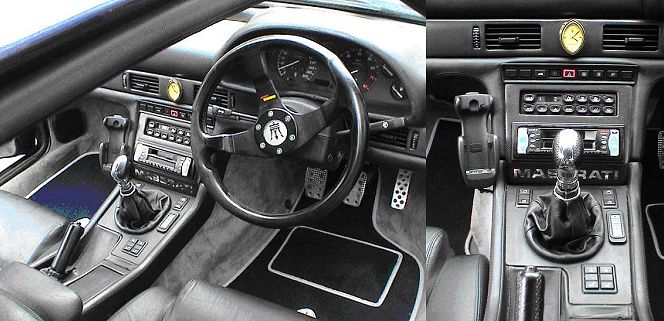
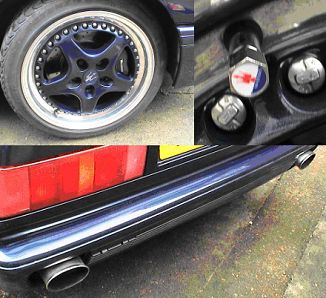
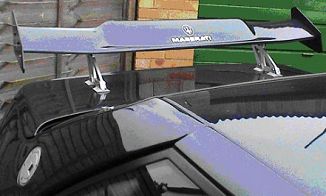
 All Ghibli Cups have the Ghibli Cup logo on either side in front of the doors. Please excuse the loss of background colour, but the is a photo of a logo from my car.
All Ghibli Cups have the Ghibli Cup logo on either side in front of the doors. Please excuse the loss of background colour, but the is a photo of a logo from my car.